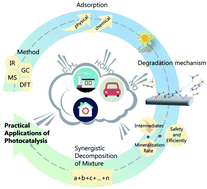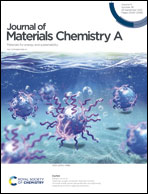Photocatalytic reaction mechanisms at a gas–solid interface for typical air pollutant decomposition
Abstract
Various technologies have been developed towards air pollution control and mitigate its adverse impact on human health and ecological environments. Photocatalysis is a promising technology because it can decompose gaseous pollutants under ambient conditions. Although photocatalytic air purification has been extensively investigated, insufficient attention is paid to the underlying degradation mechanism. This review focuses on the reaction mechanisms at a gas–solid interface for improving photocatalytic degradation efficiency. Firstly, the commonly used detection methods for gas–solid phase photocatalytic reactions are summarized. Recent research efforts toward increasing the adsorption and activation of pollutants and the generation of reactive oxygen species (ROS) are analyzed. Secondly, the degradation and conversion pathways of typical air pollutants (nitrogen oxides, formaldehyde, and toluene) are reviewed. Then, tuning the reaction processes for air pollutant decomposition is discussed according to the reaction thermodynamics and kinetics, and the approaches of intermediate inhibition and mineralization enhancement are outlined. The synergistic mechanisms of photocatalytic decomposition to air pollutant mixtures are also introduced and discussed. Finally, the status and the challenges of mechanistic research on photocatalytic air purification are critically discussed and future research directions are also proposed for its practical application.



 Please wait while we load your content...
Please wait while we load your content...